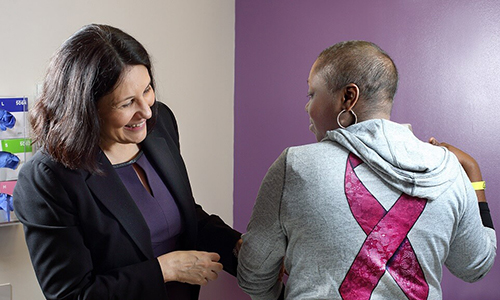Angiosarcoma of the Breast
Angiosarcoma of the Breast: Symptoms and Types
There are two types of angiosarcomas of the breast. The symptoms of angiosarcoma in the breast can vary based on the type and whether the cancer has spread to other areas of the body.
Primary angiosarcoma: This cancer occurs in people who have never been treated for breast cancer.
Primary angiosarcoma may present with:
- A thickened area of skin on the breast
- A lump in the breast
- Discolored rash or bruised appearance on the skin of the breast or arm
Secondary angiosarcoma: This cancer occurs in patients previously treated for breast cancer. It is more commonly associated with earlier radiation treatment to the breast, but can also be associated with lymphedema in the breast and arm.
Symptoms of secondary angiosarcoma can include:
- Swelling in the breast or arm
- A painful lump in the breast
- Discolored rash or bruised appearance on the skin of the breast or arm
Radiation-Induced Angiosarcoma of the Breast
“RIAS is a secondary type of angiosarcoma in the breast that is associated with having received radiation therapy for breast cancer,” says Camp. “The incidence of RIAS is very rare, about 0.2%, and typically shows up in patients six to 10 years after they’ve had radiation.”
Diagnosis: Angiosarcoma of the Breast
“Angiosarcoma can be difficult to diagnose, and requires the skill of a specialized pathologist,” Camp says. Diagnostic testing for angiosarcoma of the breast may include several methods:
- Biopsy: “Primary angiosarcoma typically requires a breast biopsy,” says Camp. “Diagnosis of secondary angiosarcoma commonly involves a skin punch biopsy, which takes a small sample of the top layer of skin to be examined.”
- Mammogram: “Mammography can detect the presence of tumors, cancer or cysts and also help us determine the extent of cancer in the breast,” says Camp.
- Breast MRI: Following a mammogram, a breast MRI produces detailed images of the breast tissue, which can detect additional tumors and show the extent of cancer in the breast.
- PET scan: This imaging method can diagnose cancer and can detect the spread of cancer throughout the body.
- Ultrasound: This noninvasive test uses sound waves to detect tumors and abnormal blood flow throughout the breast.
Schedule Your Mammogram

Angiosarcoma of the Breast Treatment
“This is a fast, aggressive cancer that calls for comprehensive treatment,” Camp says.
After your diagnosis and cancer stage are determined, treatment may include:
Surgery: Depending on the size and location of the tumor, your surgeon may recommend either a lumpectomy or a mastectomy. Surgical oncologists at comprehensive breast centers such as Johns Hopkins specialize in breast conservation surgery, and can offer patients advanced techniques in mastectomy and reconstruction of the breast.
Chemotherapy: Some patients with angiosarcoma have chemotherapy after surgery to address any remaining cancer. Decisions about chemotherapy depend on the characteristics of the specific angiosarcoma.
Radiation therapy: Radiation treatments after surgery may be added as part of your angiosarcoma treatment.Sarcoma Center

Breast Health Services







